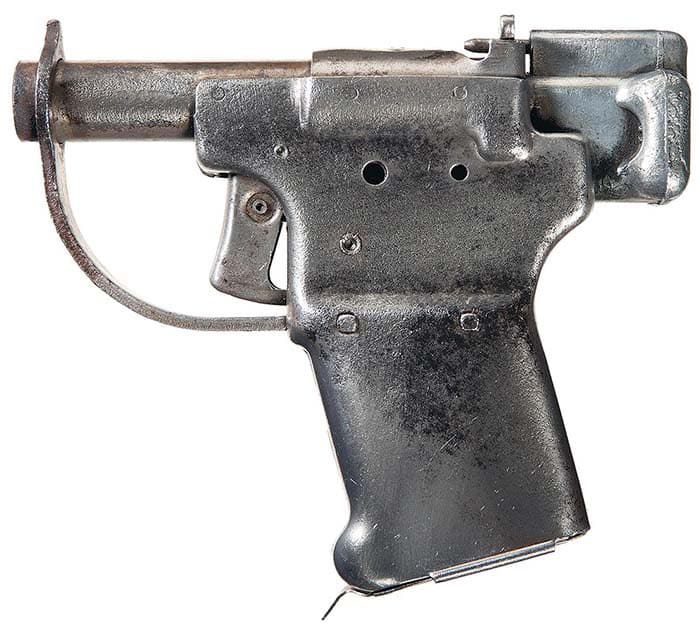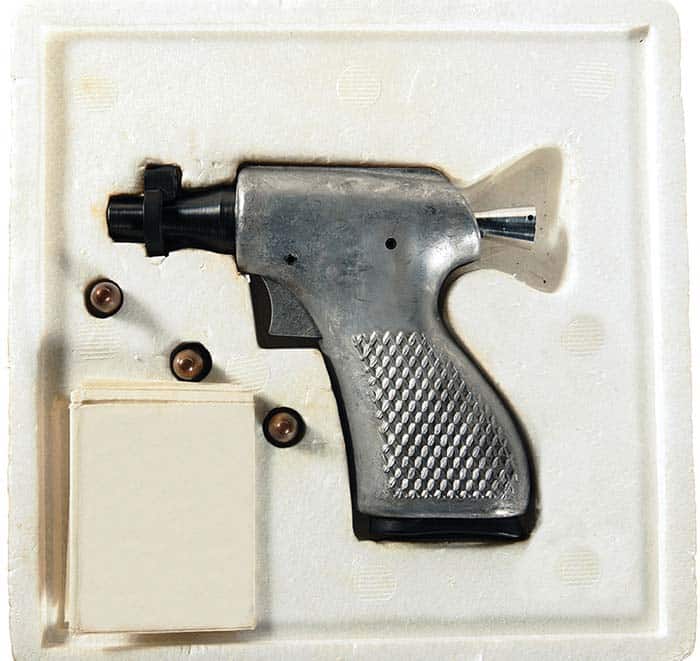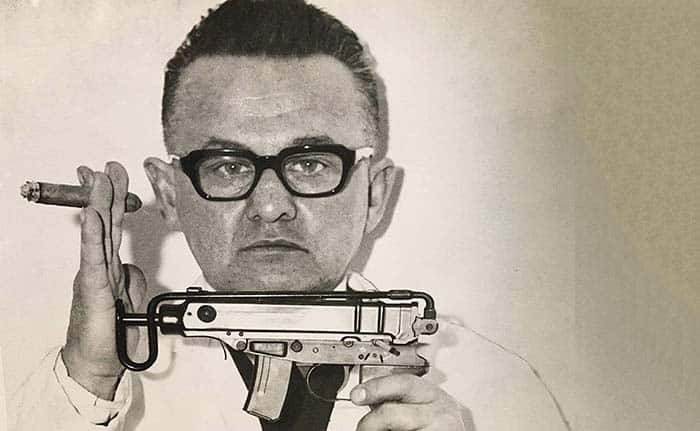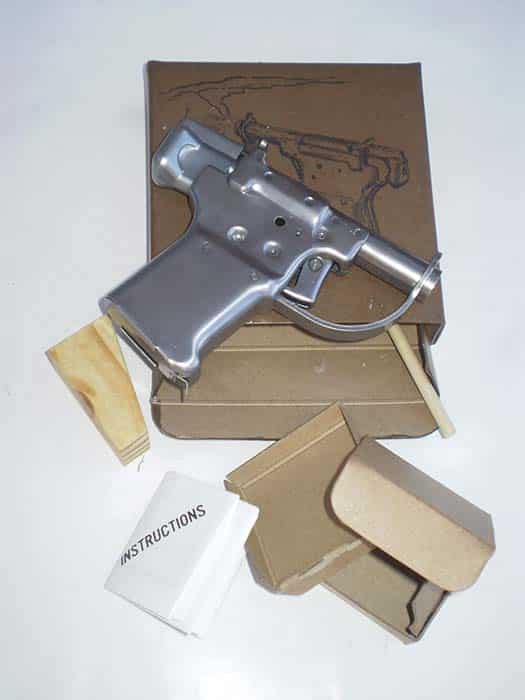By J. David Truby
Dan Shea got it wrong, Robert Bruce got it wrong, Chris Eger got it wrong, Ian Hogg got it wrong and so did Gary Paul Johnson, Jack Krcma, Dick Meadows, Keith Melton, John Minnery, T. C. Smith, Don Walsh and Yours Truly … until Jonathan Liu of the CIA’s office of Public Affairs kindly told me the truth about the mysterious CIA “Deer” Gun, as it has been known since 1962.
“This weapon is actually known as the CIA DEnied ARea Pistol, hence DEAR Pistol. It was designed for distribution to foreign fighters willing to operate behind enemy lines,” Mr. Lui informed me, sharing with me data from the Agency’s own files, including a CIA photograph of their original production DEAR Pistol.

And, it all began with the fabled OSS Liberator.
The World War II Liberator was a small, nifty, behind-the-scenes pistol. It wasn’t meant for the battlefield, though; it was meant for use as a sneaky behind-enemy-lines killer for an ally friendly OSS. About 20 years later and half-way around the world, its successor, the CIA’s Deer Gun, as it has been incorrectly known for over 55 years, hoped to continue that legacy, yet inadvertently created a puzzling reputation of its own.
The DEAR Pistol was conceived as an updated version of the Liberator pistol, a gun built by General Motor’s Guide Lamp Division. Developed for the Central Intelligence Agency (CIA) during the Vietnam conflict, the DEAR Pistol was a very simple, single-shot 9mm pistol designed to sneakily bring better weapons to the U.S.’ South Vietnamese allies fighting against their invasive local Viet Cong and the invading North Vietnamese soldiers. It was designed to be purely one-on-one deadly.
“The idea was to supply this glorified zip gun to our friendlies who weren’t afraid to carry the war close and personal to our enemy,” the late U.S. Army Major Dick Meadows, a true Special Forces icon, explained. “They’d get close, take him down with the Deer Gun, then strip him of everything usable, including his AK47and spare ammo and any material useful for intel purposes.”
The weapon was planned between operational CIA officers and our military. Discussing the project with several gun designers in the late 1950s, the goal was for the gun to be a modern version of the FP-45 Liberator, which had been discharged (an on purpose pun) after WWII.
By 1962, covert operations were already underway in Southeast Asia. According to Major Meadows, “Deep down at Langley, someone must’ve recalled those long-lost Liberators and their previously discussed updated counterparts, the Deer Gun. It was time to get them operational.”
“For some insane reason, much WWII materiel was destroyed in 1946-47. Liberator pistols were torched, melted and crushed into postwar scrap. Very few survived, and there was no inventory when President Kennedy decided to support low-profile, low-intensity counter-guerrilla warfare in Vietnam,” he explained.

The CIA called on the Chief Engineer for American Machine & Foundry (AM & F) special Firearms division, the late Russell J. Moure, a very experienced ordnance veteran who was a principal developer of the mini-gun, who also worked with and for Firearms International and Interarms. The CIA told him to create an effective successor to the Liberator, as they had discussed several years earlier. When the CIA and Moure met in 1962, discussions centered on an idea to create a lighter, smaller, simpler and far cheaper Liberator-type pistol.
Major Meadows explained, “The CIA wanted a simplistic design that was operationally sound, as well as quick and economical to manufacture. The purpose was to supply the pistol to indigenous guerrillas and irregular forces behind enemy lines. Yes, it was also an assassination gun, and it was to be part of what became known as Operation Phoenix.”
The CIA chose AM & F because it was a company well known for recreational products and had only a small, very secretive ordnance section. As author Chris Eger wrote, “Allen Dulles’people wanted someone far off the firearms radar, such as AM & F.”
One of Moure’s engineering colleagues at AM & F, who asked that his name not be used here, added, “Russ (Moure) spent 10,000 words explaining to some CIA guys what was basically a crude, ugly, but damn decent $4.00 zip gun for our Third World allies to kill one of the bad guys each time, usually during a behind-the-lines recon op. Then, to take that guy’s weapon, probably an AK for his own use. … that was the CIA program for this weapon.”
The tiny 9mm pistol with a case aluminum receiver, a screw-out-to-load 2-inch barrel, was made largely of plastic, steel and aluminum parts and would cost the U.S. approximately $3.95 apiece. The DEAR Pistol was made to be small, efficient, cheap and untraceable.

So, how did this mysterious pistol get its name wrong? U.S. Army Sgt Gary Paul Johnston suggested “Deer Gun” was an Agency codename with a sardonic, big game hunting reference. Suppressor designer Don Walsh thought the Deer Gun was named after a WWII OSS operation in Burma, “The Deer Mission.” Turns out, they were wrong, as we have just learned.
The late Vaclav “Jack” Krcma, an ordnance expert, WWII combat vet, CIA contract agent, Interarms field icon and close friend of Moure, marveled at the design of the DEAR Pistol. He had seen some of Moure’s initial actual design work. Krcma stated it was the lightest and smallest 9mm issue pistol ever developed, as well as being “of splendid design and robust construction.”
I knew Jack well, and we discussed the pistol often. He, too, called it the Deer Gun. My guess is that the CIA, in its infinite judgment of mysterious ways and means, just let people refer to it as the Deer Gun … until now.
The CIA examined and tested the prototype. Satisfied with Moure’s design, they ordered 1,000 pistols, issuing AM & F a developmental contract for $300,000. This price was higher than the originally quoted price of under $4.00 per weapon; however, with all developmental special weapons, research, testing and prototype costs had to be recovered. As Jack Krcma noted with alacrity, “In our business, we all know how that works.”

The production DEAR Pistol is 4-1/8 inches high, 5 inches long and weighs 12 ounces. The body is one piece cast aluminum, with a blued steel barrel. The raised grip is cross hatched, and the three rounds that come with each gun are stored in that hollow area. There is no trigger guard, and the sight, as such, is a grooved notch on the receiver top.
To fire the DEAR Pistol, the barrel is unscrewed, a round is loaded, and the barrel is screwed back in. The cone-shaped cocking lever is pulled back, the pistol is then aimed and fired.
However, by 1964, it was clear that Southeast Asia was bound for a major war. With that level of war a set of guidelines and parameters was passed down from the Pentagon flag pole. Their rules of engagement made the DEAR Pistol a low priority.
Diminished significance or not, the first 1,000 pistols made it to active duty in sterile condition. These guns were completely sanitized, meaning there were no serial numbers, no ordnance proofs, no ID markings, no connection to the U.S government. They were packed individually into a plain white, sturdy Styrofoam box accompanied by three rounds of 9mm ammunition which were also sterile. According to author Chris Eger, “the head stamps on the cases of those rounds were marked not with a NATO symbol, but with ‘9mm 42’ to imply that they were possibly WWII vintage bullets of German, Italian or some other origin than American.”
The packaging also contained a four-color, cartoon-style, wordless instruction sheet that visually detailed how to operate the weapon and whom to shoot with it. The instructions depicted a generic guerrilla using a DEAR Pistol to shoot an enemy soldier bearing a Soviet armband, hammer and sickle included. Ironically, that armband is the only identification marking of any kind found on the weapon, its container or the instructions.
According to Krcma, of the weapons delivered to the Defense Intelligence Agency (DIA), approximately 150 were sent for field testing in Southeast Asia. There are no official records available that any of the DEAR Pistols were used beyond controlled, non-combat testing. However, one U.S. military officer relayed a story to me in which he accompanied a patrol of both U.S. and Vietnamese Special Forces in 1963, during which two DEAR Pistols were carried for what he referred to as “active evaluation.”
“We had run a successful ambush and were returning for extraction with four prisoners, three of whom were wounded. The unwounded man noisily resisted restraint. Because the potential for hostile reaction to us being there was very real, our senior man decided to terminate the recalcitrant prisoner.”
“That’s when I saw the Deer Pistol ‘field-tested.’ One shot was fired from a range of two feet into the back of the base of the man’s head. He lurched forward and fell quite dead. We then effected our extraction with the other, very silent prisoners, all officers.”
Thus, by 1964, the DEAR Pistol was officially cleared for field issue. It was listed in the CIA’s special weapons inventory and carried stock number 1395-H00-9108. However, since its change in status, little information has been released about this limited issue weapon. Until now, the CIA has denied requests for materials regarding the DEAR Pistol. AM & F, totally out of the ordnance business for years, refused to provide me any information.
“Over the years, I had seen Deer Guns at one military museum, at a CIA facility and at a few ordnance research facilities,” Jack Krcma told me in 2005. “But, they must have grown legs and walked off, because they aren’t there anymore. Where did they go, and I wonder who has them now?”
There is at least one DEAR Pistol at the CIA Museum, and there is also one at the JFK Museum at Fort Bragg. That has been confirmed.
However, there are some other stories. A DEAR Pistol was reportedly confiscated in Mexico in 1970, before it could be used to assassinate a Cuban official. This account is totally unconfirmed. The Deer Gun was mentioned and accurately described in William Caunitz’s 1985 novel, One Police Plaza.
Of the original 1,000 weapons produced, maybe 10 to 20 remain in circulation, according to the well-known collector, Keith Melton. Eger wrote that one was legally sold at a recent auction for over $22,000. Another was sold legally by Rock Island Auction in 2011 for $25,875. Robert Bruce photographed another one for his 2003 SAR article titled “The CIA’s Deer Gun in Vietnam” (Vol. 6, No. 4). Three of his pictures are with this article, the first color photos and also the first with a person holding the DEAR Pistol.
He told me, “It belonged to a 1st Cav Special Ops vet who was on a recon mission in Vietnam and saw the weapon there. He said he ‘acquired’ it and was able to get it home.”
The remainder have apparently disappeared into collectors’ quiet and private inventories. The DEAR Pistol may not have been successful in combat, but its reputation continues to be successfully enigmatic to this day.
| This article first appeared in Small Arms Review V21N8 (October 2017) |












